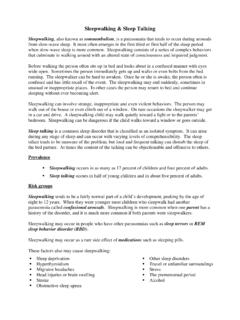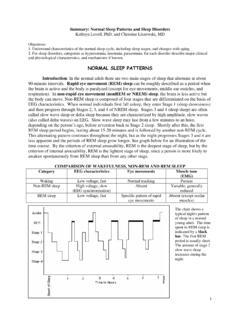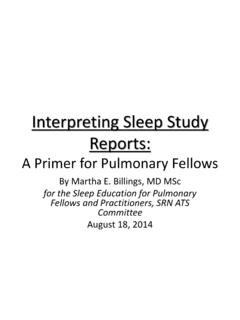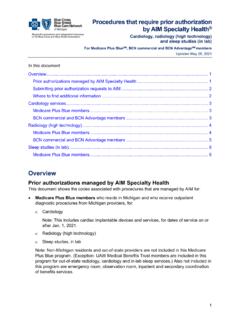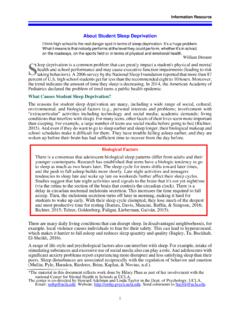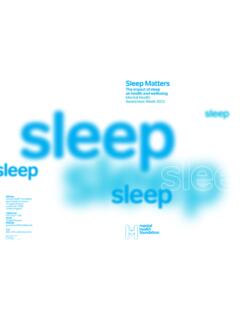Transcription of LCD for Polysomnography and Sleep Studies (L26428)
1 Contractor InformationContractor Name National Government Services, Inc. Contractor Number 00803 Contractor Type Carrier LCD InformationLCD ID Number L26428 LCD Title Polysomnography and Sleep Studies Contractor's Determination Number L26428 Cor#1 AMA CPT / ADA CDT Copyright Statement CPT codes, descriptions and other data only are copyright 2007 American Medical Association (or such otherdate of publication of CPT). All Rights Reserved. Applicable FARS/DFARS Clauses Apply. Current DentalTerminology, (CDT) (including procedure codes, nomenclature, descriptors and other data contained therein)is copyright by the American Dental Association. 2002, 2004 American Dental Association. All rightsreserved. Applicable FARS/DFARS apply. CMS National Coverage Policy Language quoted from Centers for Medicare and Medicaid Services (CMS). National CoverageDeterminations (NCDs) and coverage provisions in interpretive manuals is italicized throughout the and coverage provisions in interpretive manuals are not subject to the Local Coverage Determination(LCD) Review Process (42 CFR [b] and 42 CFR 426 [Subpart D]).
2 In addition, an administrative lawjudge may not review an NCD. See 1869(f)(1)(A)(i) of the Social Security otherwise specified, italicized text represents quotation from one or more of the following CMSsources:Title XVIII of the Social Security Act (SSA):Section 1833(e) prohibits Medicare payment for any claim which lacks the necessary information to processthe 1862(a)(1)(A) excludes expenses incurred for items or services which are not reasonable andnecessary for the diagnosis or treatment of illness or injury or to improve the functioning of a malformedbody for Polysomnography and Sleep Studies (L26428)LCD InformationLCD ID Number Code of Federal Regulations:42 CFR Section indicates that diagnostic tests may only be ordered by the treating physician (or othertreating practitioner acting within the scope of his or her license and Medicare requirements).Federal Register:Federal Register, Vol. 65, No. 68, April 7, 2000, page. 18434 is the Medicare Program Prospective PaymentSystem for Hospital Outpatient Services Final Publications:CMS Publication 100-2, Medicare Benefit Policy Manual, Chapter 6:50 Sleep Disorder ClinicsCMS Publication 100-2, Medicare Benefit Policy Manual, Chapter 15:70 Sleep Disorder ClinicsCMS Publication 100-3, Medicare National Coverage Determinations Manual, Chapter 1 Electrosleep Continuous Positive Airway Pressure (CPAP) Therapy For Obstructive Sleep Apnea (OSA)(Effective April 4, 2005)CMS Publication 100-4, Medicare Claims Processing Manual, Chapter 4, provides information on theOutpatient Prospective Payment System (OPPS).
3 Coverage Decision Memorandum for Continuous Positive Airway Pressure (CPAP) Therapy for ObstructiveSleep Apnea (OSA) (CAG-00093R2) Primary Geographic Jurisdiction New York - Downstate Oversight Region Region II Original Determination Effective Date For services performed on or after 04/01/2008 Original Determination Ending Date LCD InformationLCD ID Number Revision Effective Date For services performed on or after 04/01/2008 Revision Ending Date Indications and Limitations of Coverage and/or Medical Necessity Abstract: Sleep complaints and disorders are widespread. Although approximately 40 million Americans suffer fromchronic Sleep disorders, 95% of these are undiagnosed and untreated. The aging process places elderlypersons at risk for Sleep disturbances as the amount of time spent in deeper levels of Sleep diminishes. Manysleep disorders can be managed by primary care physicians; however, when abnormal Sleep patterns are noteasily explainable and further evaluation is necessary, Sleep Studies may be nocturnal Sleep in adults displays a consistent organization from night to night.
4 Sleep consists of twodistinct states: rapid eye movement (REM), also called dream Sleep and non-rapid eye movement (NREM),which is divided into four stages. NREM stages 1 and 2 are referred to as light Sleep and stages 3 and 4 asdeep or slow-wave Sleep . Dreaming occurs mostly in REM and to a lesser extent in NREM Sleep . Sleep is acyclic phenomenon, with four or five REM periods during the night accounting for about one-fourth of thetotal night's Sleep (1 1/2 - 2 hours). Sleep Studies and Polysomnography refer to the continuous and simultaneous monitoring and recording ofvarious physiological and pathophysiological parameters of Sleep for 6 or more hours with physician review,interpretation and report. The Studies are performed to diagnose a variety of Sleep disorders and to evaluate apatient s response to therapies such as continuous positive airway pressure (CPAP). Polysomnography isdistinguished from Sleep Studies by the inclusion of Sleep is defined to include, but is not limited to, the following.
5 A 1-4 lead electroencephalogram (EEG) to measure global neural encephalographic activity usingelectrodes placed on the scalp Electrooculogram (EOG) to measure eye movements using electrodes placed near the outer canthus ofeach eye A submental electromyogram (EMG) to measure submental electromyographic activity usingelectrodes placed over the mentalis, submentalis muscle, and/or masseter regions Rhythm electrocardiogram (ECG) with two or three chest leads Nasal and/or oral airflow via mercury switches or by direct observationLCD InformationLCD ID Number Ventilation and respiratory effort by chest-wall and abdominal movement measured using straingauges, piezoelectric belts, inductive plethysmography, impedance or inductance pneumography,endoesophageal pressure, or by intercostal EMG Gas exchange (oxygen saturation (SpO2)) by oximetry, transcutaneous monitoring, or end-tidal gasanalysis Extremity muscle activity, motor activity-movement using EMG Body positions via mercury switches or by direct observation Recordings of vibration (frequency and/or volume) may be recorded Transcutaneous CO2, esophageal pH, penile tumescence, and bipolar EEGM ultiple Sleep latency testing (MSLT) involves several 20-minute nap opportunities offered at 2-hourintervals.
6 MSLT objectively assesses Sleep tendency by measuring the number of minutes it takes the patientto fall asleep. Conversely, the maintenance of wakefulness test (MWT) requires the patient to try to stayawake. MSLT is the better test for demonstration of Sleep -onset REM periods, a determination that isimportant in establishing the diagnosis of narcolepsy. To insure validity, proper interpretation of the MSLTcan only be made following a Polysomnography performed on the preceding disorder clinics are facilities in which certain conditions are diagnosed through the study of clinics are for diagnosis, therapy, and research. Sleep disorder clinics may provide some diagnostic ortherapeutic services that are covered under Medicare. These clinics may be affiliated either with a hospitalor a freestanding facility. Whether a clinic is hospital-affiliated or freestanding, coverage for diagnosticservices under some circumstances is covered under provisions of the law different from those for coverageof therapeutic services.
7 (CMS Publication 100-2, Medicare Benefit Policy Manual, Chapter 6, Section 50).For a study to be reported as a polysomnogram, Sleep must be recorded and staged. Sleep Studies should beperformed in a hospital, Sleep laboratory or by an Independent Diagnostic Treatment Facility that issupervised by a physician (MD/DO) trained in analyzing and interpreting the recordings and should beattended by a trained technologist. (For exception to the attendance requirement, see the section on sleepapnea below.)Indications:A - Criteria for Coverage of Diagnostic TestsAll reasonable and necessary diagnostic tests given for the medical conditions listed in subsection B arecovered when the following criteria are met: The clinic is either affiliated with a hospital or is under the direction and control of testing routinely performed in Sleep disorder clinics may be covered even in the absenceof direct supervision by a physician; Patients are referred to the Sleep disorder clinic by their attending physicians, and the clinicmaintains a record of the attending physician s orders; and The need for diagnostic testing is confirmed by medical evidence, , physician examinations andlaboratory InformationLCD ID Number Diagnostic testing that is duplicative of previous testing done by the attending physician to the extent theresults are still pertinent is not covered because it is not reasonable and necessary under 1862(a)(1)(A) ofthe Act.
8 (CMS Publication 100-2, Medicare Benefit Policy Manual, Chapter 15, Section 70).B - Medical Conditions for Which Testing is CoveredDiagnostic testing is covered only if the patient has the symptoms or complaints of one of the conditionslisted below. Most of the patients who undergo the diagnostic testing are not considered inpatients, althoughthey may come to the facility in the evening for testing and then leave after testing is over. The overnight stayis considered an integral part of these Narcolepsy - This term refers to a syndrome that is characterized by abnormal Sleep tendencies, ,excessive daytime sleepiness or disturbed nocturnal Sleep . Related diagnostic testing is covered if the patienthas inappropriate Sleep episodes or attacks ( , while driving, in the middle of a meal, in the middle of aconversation), amnesiac episodes, or continuous disabling drowsiness. The Sleep disorder clinic must submitdocumentation that this condition is severe enough to interfere with the patient s well being and health beforeMedicare benefits may be provided for diagnostic testing.
9 Ordinarily, a diagnosis of narcolepsy can beconfirmed by three Sleep naps. If more than three Sleep naps are claimed,.. persuasive medical evidencejustifying the medical necessity for the additional test(s) [will be required].The diagnosis of narcolepsy is usually confirmed by an overnight Sleep study ( Polysomnography ) followedby a multiple Sleep latency test (MSLT). The following measurements are normally required to diagnosenarcolepsy: Polysomnographic assessment of the quality and quantity of nighttime Sleep ; Determination of the latency of the first REM episode; MSLT; and The presence of REM- Sleep Polysomnography and MSLT occasionally fail to identify narcolepsy. Repeat Polysomnography maybe indicated: if the first study is technically inadequate due to equipment failure; if the subject could not Sleep or slept for an insufficient amount of time to allow a clinical diagnosis; if initiation of therapy or confirmation of the efficacy of prescribed therapy is needed; or if the results were inconclusive or Sleep Apnea - This is a potentially lethal condition where the patient stops breathing during Sleep .
10 Threetypes of Sleep apnea have been described (central, obstructive, and mixed). The nature of the apnea episodescan be documented by appropriate diagnostic testing. Ordinarily, a single polysomnogram andelectroencephalogram (EEG) can diagnose Sleep apnea. If more than one such testing session is claimed,..persuasive medical evidence justifying the medical necessity for the additional tests [will berequired]..(CMS Publication 100-2, Medicare Benefit Policy Manual, Chapter 15, Section 70).LCD InformationLCD ID Number The diagnosis of Sleep apnea may be made using the following (PSG) performed in a Sleep laboratory; home Sleep monitoring device of Type II; home Sleep monitoring device of Type III; home Sleep monitoring device of Type IV, measuring at least three channels (CAG-00093R2) Sleep apnea may be due to an occlusion of the airway (obstructive apnea), absence of respiratory effort(central Sleep apnea) or a combination of these factors (mixed Sleep apnea).Obstructive Sleep apnea (OSA) may be caused by one of the following: Reduced upper airway caliber due to obesity; Adenotonsillar hypertrophy; Mandibular deficiency; Macroglossia; Upper airway tumor; Excessive pressure across the collapsible segment of the upper airway.

